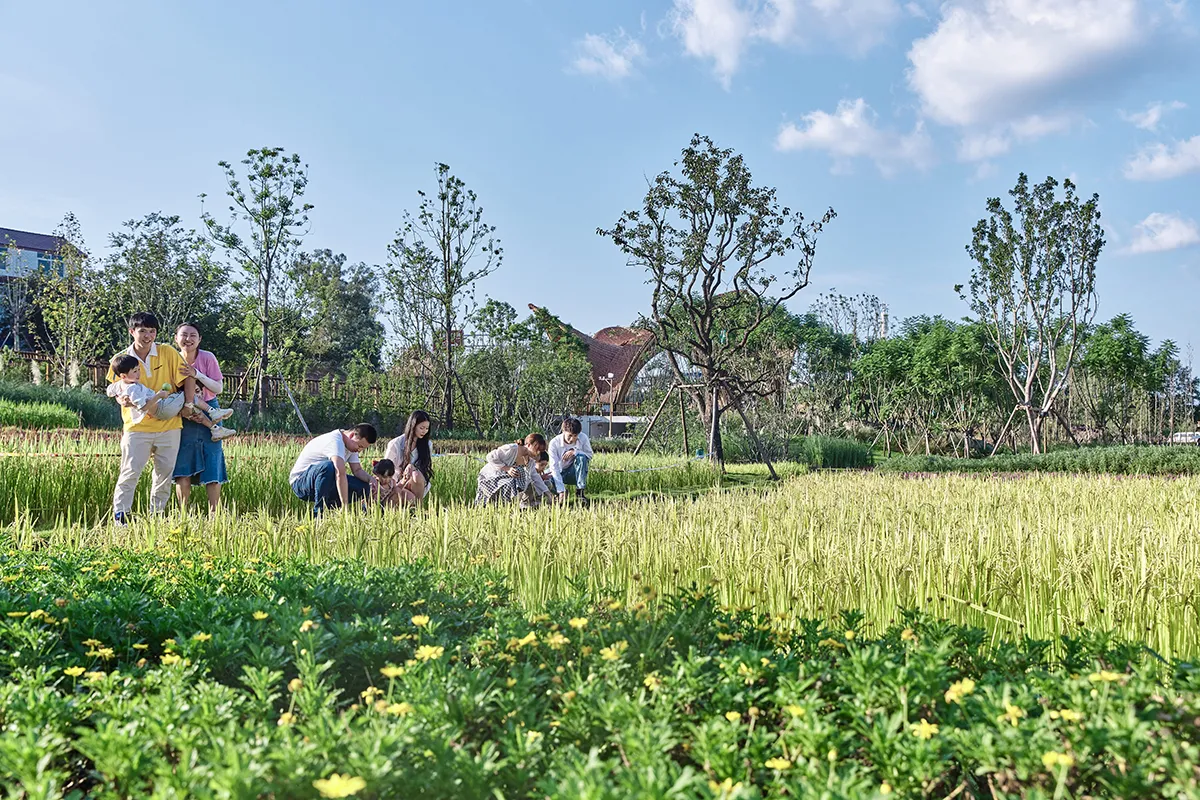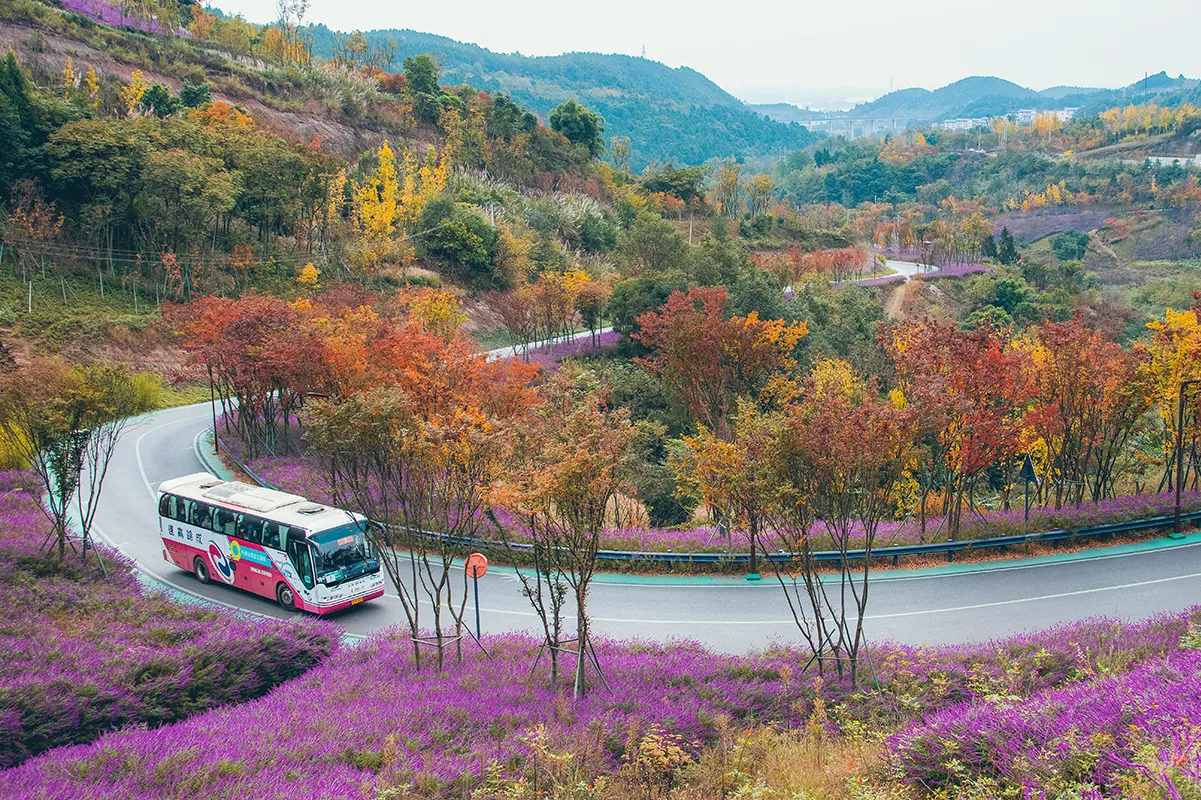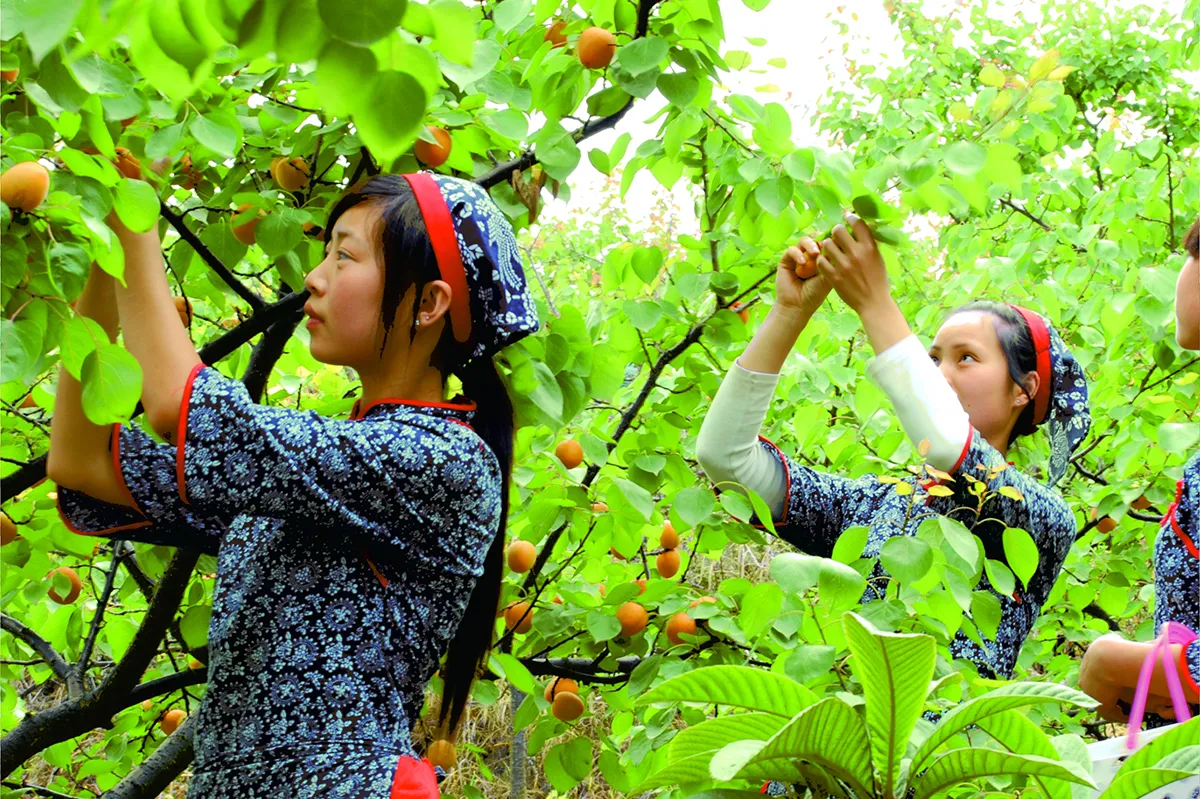Benefits of Urban Greening
Harnessing the Power of Plants
To support the Programme, Chengdu has established the Longquan Mountain Urban Forest Park Protection and Development Center and the Park City Development Academy. These institutions have launched 49 research projects on hydrology, soil, climate, biology and geological environments in collaboration with China’s renowned scientific research institutes.
So far, 45 research outcomes have been delivered and applied to the implementation of the project. Furthermore, academician workstation and training bases were set up to conduct research into key projects, including forest vegetation mapping and the construction of twin platforms for intelligent management.
These endeavours provide a strong guarantee for the implementation of the Programme in a rational, forward-looking and innovative manner as well as consistent exploration of the potential benefits that the harmonious co-existence between man and nature may deliver in the process of urban development.
Delivering Multiple Benefits
The project of the Longquan Mountain Urban Forest Park is an important part of Chengdu’s urban development plans and has been recognised at national, provincial and municipal levels.
At national and provincial levels, the central government and the provincial government of Sichuan have endorsed the project through various strategic plans, such as the strategic plan of building the “fourth pole” of China’s city cluster, the Outline of the Construction Plan for the Chengdu-Chongqing Economic Circle, the Master Plan for Chengdu Building a Park City Demonstration Area Exercising the New Development Philosophy and the Plan for the Development of Chengdu Metropolitan Area. These documents clearly demonstrate government support for the construction of the Longquan Mountain Urban Forest Park and reinforce the role of Longquan Mountain as an “Urban Green Heart”.
At the municipal level, Chengdu has formulated the Implementation Plan for the High-quality Protection and Development of the Longquan Mountain Urban Forest Park and the Regulations of Chengdu for the Protection of the Longquan Mountain Urban Forest Park.
These documents provide comprehensive support for the development of the Longquan Mountain Urban Forest Park, covering aspects such as spatial planning, protection mechanisms, financial guarantees, control of development intensity, and the ratio of blue space to green space.
Additionally, Chengdu has established the Longquan Mountain Urban Forest Park Management Committee, which is specifically responsible for implementing the Programme and coordinating government efforts at all levels and the efforts of other stakeholders during the development of the park.
The City’s Bold and Innovative Vision
1. Innovation in philosophy of ecological restoration. The Programme aims to transition from a narrow focus on forest protection and restoration to a holistic and systematic approach that encompasses the conservation and governance of mountains, waters, forests, farmlands, lakes and grasslands. With a strong emphasis on ecosystem and biodiversity conservation.
2. Innovation in application of ecological technologies. Plants for afforestation in this project were local plants with identified genotypic origins within Sichuan. For each species of conservation value, multiple collection sites are secured to maximise the diversity of natural succession for future urban applications and enhance resilience against climate change and pests. Drawing on the few remaining patches of pristine woodland, working closely with local residents and adopting a quasi-natural and ecological landscape approach to select species and seedlings. Our reforestation endeavour begins within key areas and then gradually extends to other areas. Through the restoration of the forest system, we aim to transform the mountain mass into an “urban sponge” that can utilise and conserve water to the maximum extent.
3.Innovation in financing. In the past, ecological conservation projects were mainly funded by the government. For this Programme, we have developed special financial, fiscal and tax support policies, as well as resource matching policies, to attract private and financial capital across all stages of ecological conservation and restoration – from investment and design to restoration, management and maintenance. By guiding private capital to integrate the concept of ecological conservation into consumption scenarios such as cultural experiences, tourism and sports.
Partnerships and Collaboration
Prior to implementation, we sought consultancy services for the Green Heart Project from the global consulting community. We established an 11-member review committee with top Chinese and foreign experts in the fields of urban and rural planning, ecological landscaping and architectural design. We called for bids globally and invited 58 leading consortiums, including LDA Design and James Hitchmough Design and Management Ltd, to provide consulting services.
During implementation, the development of the Longquan Mountain Urban Forest Park involves multiple fields such as forestry, architecture, planning, landscape and transportation. It has engaged various government departments and received support from renowned Chinese research institutes including the Chinese Academy of Sciences, the Chinese Academy of Forestry, the State Information Center of China, and the Development Research Center of China Geological Survey. These institutes have conducted fundamental research focusing on ecological restoration techniques, biodiversity conservation and governance of soil erosion. To address drought and water scarcity in the Longquan Mountain, we have initiated the “Hundred-Lake, Thousand-Pond, and Ten Thousand-Reservoir” project with the support of the Chengdu Water Authority.
Addressing Urban Challenges
The Issue
Firstly, the Programme aims to tackle soil erosion. Longquan Mountain used to be a major area of soil erosion in Sichuan, with the affected area hitting 112,000 square kilometres. It was the primary source of sediment entering the Three Gorges reservoir area of the Yangtze River. Thanks to recent ecological conservation and restoration efforts, the soil erosion modulus has successfully decreased by 240.5 tons/km2-year, marking significant progress in soil erosion control.
Secondly, the Programme aims to address urban sprawl and related urban challenges. By building the Longquan Mountain Urban Forest Park, urban air corridors and wildlife migration corridors in the future heart of Chengdu, an ecological network where greenery and urban spaces are seamlessly integrated is formed. This creative urban ecological paradigm known as “one mountain connecting two wings” will greatly enhance the city’s liveability.
The third problem the Programme aims to solve is the conservation of the natural habitats of wildlife. Within the project area spanning 1,275 square kilometres, ecologically sensitive areas are identified. An area of 364.6 square kilometres is delineated as the core ecological conservation zone, which focuses on ecological conservation and prohibits development and construction; and Longquan Lake and Changsongsi are designated as natural habitats for wildlife.
A Nature Orientated Future
The implementation of the Green Heart Programme has provided urban residents with a number of accessible, participatory and perceptible green and ecological open spaces. Each year, nearly 20 million people are drawn to visit Longquan Mountain through a range of recreational, leisure, cultural, sporting and educational activities, such as the International Peach Blossom Festival, the CHINA100 Mountain Cross Country Series, the Cactus Music Festival, and the Nature Watching Festival.
Furthermore, the Programme offers opportunities for enterprises to engage in ecological industry development. Some enterprises capitalise on the favourable ecological resources of the Longquan Mountain Urban Forest Park to cultivate featured fruits, edible fungi, and engage in animal husbandry and breeding, as well as other agricultural and forestry industries. They also strive to foster positive interactions among agriculture, forestry, culture, tourism, sports, and other sectors. A number of projects integrating agriculture, business, culture and tourism have emerged, such as My Garden and Newhope Seed Park. These projects have not only expanded the benefits of the eco-industry but also derived added value from ecological conservation.
Nature Positive Solutions
Implementation
In the last five years, the development of the Longquan Mountain Urban Forest Park has resulted in the addition of approximately 70.6 million square metres of new forested areas. This has increased the per capita forest area for Chengdu people by an average of 3.35 square metres. Additionally, the park captures an average of 1.218 million tons of carbon dioxide and releases 889,000 tons of oxygen annually. The recorded species of plants and animals has also increased from 1,147 in 2020 to 1,724 currently. Moreover, the park has contributed about 40,000 tons of carbon absorption capacity to the Chengdu 2021 FISU World University Games, promoting low-carbon sports initiatives globally. A total of 24,700 people living in Longquan Mountain have voluntarily relocated to cities, towns and featured communities, freeing up 24.04 million square metres of space for ecological development.
We have organised large-scale tree planting activities. Over the past five years, the Programme has attracted 660,000 individuals from all walks of life to participate in tree planting within the Longquan Mountain Urban Forest Park. More than 69.8 million yuan of greening funds has been raised from the public, resulting in afforestation across more than 19 million square metres of land. Additionally, the Programme has utilised the power of the internet to promote tree-planting activities and increase public awareness about the importance of ecological conservation.
Feasibility
Financial support: In the past five years, the Longquan Mountain Urban Forest Park has received a fiscal subsidy of 1 billion yuan from various levels of government to support its ecological conservation and restoration, infrastructure construction, and creation of ecological consumption scenarios. Additionally, the park has raised 10 billion yuan through China’s supportive policies for green finance. This funding is used for the ecological conservation and protection of Longquan Mountain and the construction of the national reserve forest project. Chengdu is currently applying for state fiscal support targeting the green development of the Yangtze River Economic Belt and the systematic governance of mountains, waters, forests, farmlands, lakes and grasslands to further ensure the implementation of the Programme.
Policy support: At national and provincial levels, Chengdu is actively seeking supportive policies that aim to conserve and restore important ecological systems and develop city clusters in Sichuan and Chongqing. At the municipal level, the Programme is striving to be included in policies that support the construction of Chengdu Smart City Brain and the organic renewal of the city.
Multi-Stakeholder Support
To minimise the impact of local activities on the ecological environment and promote the implementation of the Programme, the government has provided public service positions such as forest rangers and fire wardens to local people. These positions have helped transform their production and living styles. For example, many local farmers have become forest rangers, with some holding the job for over 20 years.
Bird enthusiasts have also formed volunteer teams. These volunteers undergo bird knowledge and values tests before joining the team and then carry out long-term monitoring of bird migrations, regularly releasing the data they collect. For example, Alex was a bird lover from Shenzhen. He had a birding tour to Longcanggou and Wawushan Forest Parks in Ya’an, a city to the west of Chengdu. After he returned from Ya’an to Chengdu, he visited the park despite a tight flight schedule because he was recommended to do so by a friend. Impressed by the park, he said, “Chengdu is a beautiful city. I will visit it again in the future.”
Management and Maintenance
The development of the Longquan Mountain Urban Forest Park has been included in China’s forest chief scheme. Following the scheme, 426 government officials and heads of villages, communities and other self-governing organisations have been designated as forest chiefs. They are responsible for promoting biodiversity conservation, forest resources conservation and the commercialisation of ecological value to ensure the advancement of the Programme.
The development of the Programme has attracted many photographers, bird-watchers, and camping enthusiasts, bringing additional pressure on forest protection, especially in terms of forest fire prevention. To address these challenges, a 100-kilometre long firebreak has been established by planting fire resistant plants along main traffic arteries and rivers. Additionally, 87 intelligent overhead surveillance cameras and 293 checkpoints have been set up for fire monitoring. Two forest fire fighting teams with 80 members in total are stationed on the mountain to command and carry out fire rescue operations in a timely manner.
Measuring and Reporting Impact
Monitoring Results
The Management Committee, in collaboration with the Chengdu Institute of Biology, Chinese Academy of Sciences, has developed an index system for accounting the value of eco-services provided by the Longquan Mountain Urban Forest Park. According to their calculation, the Gross Ecosystem Product (GEP) generated by the park in 2020 was worth 64.137 billion yuan. The Management Committee has also developed an intelligent monitoring plan that incorporates new technologies such as satellite remote sensing, geographic information systems, unmanned aerial vehicles and the Internet of Things. Specifically, 28 micro-weather stations, 4 soil erosion monitoring points, 34 fixed plots for biodiversity monitoring as well as 3 raptor monitoring points have been set up to carry out long-term and regular monitoring of typical plant communities, ecological types and ecological and environmental elements in the park. The monitoring covers 273 items across 61 categories. These monitoring stations and points are also responsible for the real-time collection, long-term storage and integrated application of data.
Monitoring data has shown that the average temperature in August, the hottest month in the project area, is 4°C lower than in the downtown area. Additionally, the average annual concentration of negative oxygen ions and average air oxygen content inside the forest are approximately 23% and 5.6% higher, respectively, compared to outside the forest. These findings indicate that the Programme has effectively improved the city’s liveability.
Demonstrating Progress
We have organised the International High-level Forum on Sustainable Urban Development and the Park City Forum to release the results achieved by the Programme, share monitoring data, and attract researchers, scholars and enterprises to participate in ecosystem monitoring, biodiversity conservation and the commercialisation of ecological value. We regularly hold nature watch festivals, citizen experience officer programmes, science popularisation activities and opinion solicitation activities. We use various media platforms such as broadcasting, television, newspapers and websites to widely publicise and report on the Programme, encouraging the public to participate in activities at Longquan Mountain, such as raptor watching, sunrise watching and enjoying the night view. These activities, such as “Climbing Longquan Mountain at Night” and “Watching Raptors in Spring and Autumn,” have become popular among the citizens of Chengdu. The activity of “watching sunrise on Longquan Mountain” has been at the top of the trending topics of Chinese social media platforms such as Weibo, TikTok and Xiaohongshu many times.
Measuring Impact
We have developed comprehensive databases encompassing plant communities and biodiversity, along with graphical representations of biodiversity specific to Longquan Mountain. Through in-depth analysis of vegetation types, the structure of biodiversity, biome composition and the trajectory of plant succession, we have acquired valuable insights into the ecosystem of Longquan Mountain. This information will provide support for subsequent stages of vegetation restoration, landscaping, project site selection, scientific research endeavours and science popularisation activities.
We have developed distribution maps for various categories of flora and fauna, including key protected, rare and endangered species, as well as invasive species and different vegetation types. These maps are instrumental in facilitating the systematic planning and construction of spatial systems for species protection, ecological corridors for species migrations and genetic exchanges, and nurseries and seedling bases for national reserve forests to adapt to local conditions.
Liu Bin is a professional photographer who has captured many photos of Longquan Mountain’s natural scenery, flora and fauna. Noticing the positive changes that have occurred since the implementation of the Programme, he said, “What impresses me most is the increase in trees and the beauty of the forests in various colours.”
Learning and Transferability
Adaption and Enhancement
As the conservation and development of the Longquan Mountain Urban Forest Park progresses, a few problems have emerged such as poor coordination, insufficient support for fundamental scientific research, an incomplete ecological monitoring system, and limited channels for commercialising the ecological value. In response, Chengdu has restructured and optimised the Leading Group for the Conservation and Development of the Longquan Mountain Urban Forest Park and established the Longquan Mountain Conservation and Development Center to ensure the smooth implementation of the Programme.
During the implementation process, we have faced challenges related to limited ecological development space. To overcome this, we have established a mechanism linking the interests of local people with the Programme through collaboration with local village (community) organisations and village-level collective economic organisations. Compensation is provided for local people for the use of forest land, garden land and forest management rights. This approach has transformed resources into assets, added value for all parties involved and provided a solution to creating space for ecological development.
Potential for Replication
The first benefit the Programme delivers is employment and improvement in living conditions. Longquan Mountain is home to 270,000 people and the high-intensity farming activities have caused great disturbance to local ecological environment. During the implementation of the Programme, the government improved living conditions and created job opportunities for locals in cities. Over the past five years, approximately 24,700 local residents have been attracted to voluntarily move from the mountainous areas to towns and cities. This has freed up 24.04 million square metres for ecological development. Concurrently, large-scale afforestation has generated over 5,000 jobs related to ecological conservation and ecological consumption scenario creation. Local residents are given priority for involvement in related work. This effectively addresses the employment and income challenges faced by local residents, garnering widespread public support for the Programme.
The second benefit is brand incubation. During the conservation and development of the Longquan Mountain Urban Forest Park, drawing on its advantages in ecological resources, we have organised a series of activities, such as ecological research, science education, sports and nature experiences, among others. In this process, we have fostered the “Tianfu Longquan Mountain” brand unexpectedly. Through commercial promotion and operations, this brand has continually grown in value, enhancing the Programme’s social influence and appeal.
Inspiring Other Cities
The Programme has been incorporated in Chengdu’s development plan and is a key component to the city’s vision of building a beautiful and liveable park city. Chengdu has formally introduced the Park City Index (Framework System), outlining clear goals and measurable indicators.
During the initial stages of implementation, Chengdu released the Regulations for the Protection of the Chengdu Longquan Mountain Urban Forest Park. These regulations provide explicit guidelines concerning regional planning and control, land use and ecological conservation. It is the city’s first set of regulations specifically tailored to urban forest parks.
Based on the 2020 data and the Technical Guidelines for Accounting Gross Product of Terrestrial Ecosystems and the Environmental-Economic Accounting System – Ecosystem Accounting, we have established an ecological value evaluation system for Longquan Mountain, focusing on specific geographic units. Regular GEP calculations are conducted every five years.
Resilience
Reducing Negative Impacts and Ensuring Sustainability
The park is divided into core ecological conservation zones, ecological buffer zones and ecological recreation zones. Energy-intensive projects with high pollution, backward production capacity and insufficient environmental compliance are being gradually relocated, closed or demolished. We have prepared and implemented the Special Plan for Industry Development in the Chengdu Longquan Mountain Urban Forest Park. We have established a “3+X” low-carbon industrial system centred on ecological conservation, with low-carbon agriculture and forestry, tourism and leisure as well as healthcare as the leading industries. Through the development of green and low-carbon agriculture and forestry, we have cultivated diverse featured products, such as the peach in Longquanyi District and olive in Jintang County. Additionally, a newly planted forest of 1.33 square kilometres is selected to serve as a pilot plot for monitoring carbon sinks. The “Carbonwise Tianfu” mechanism, a method of measuring carbon reduction by afforestation has been formulated and publicly released. Carbon-neutral forests have been built, realising net zero emissions for events like the second International High-Level Forum on Sustainable Urban Development and the Cybersecurity Technology Forum during China Cybersecurity Week.
Environmental Considerations
Leveraging the 377.33 square kilometres of the national reserve forests, the Programme enhances soil quality by planting water conservation forests on steep slopes and eliminates or mitigates geological hazards caused by water systems through water diversion. Through the implementation of the “Hundred-Lake, Thousand-Reservoir and Ten Thousand Pond” water conservation project, new water source projects are meticulously planned based on Longquan Mountain’s topographic and geological conditions. This involves constructing, reconstructing and expanding water storage projects like reservoirs, weirs and farm ponds. Various water-saving initiatives, including pipeline water transmission and drip irrigation, are promoted to adapt to local conditions. Advanced technologies like ground-based cloud seeding systems are used for artificial precipitation enhancement to secure water resources necessary for the Programme. Referencing the native vegetation of Longquan Mountain, 296 plant species best suited for the local environment are selected to create an uneven-aged, multi-layered, mixed and close-to-nature forest.
Use of Natural Resources
To address disasters arising from extreme climate change, at the initial stages of its implementation, the Programme integrated the concept of sponge city into the park’s Master Plan, Special Plan for Ecological Landscaping and Greening, Guidelines for Ecological Restoration and Integral Landscaping, and Guidelines for Scientific Greening. Inspired by Germany’s close-to-nature management approach, we have conducted detailed surveys and research on each geographical unit, creating a site quality map for Longquan Mountain. We have also conducted a site quality evaluation of the park, planted new forests, restored degraded forests, and sealed off mountain areas to facilitate afforestation, with ongoing monitoring to assess effectiveness.





























